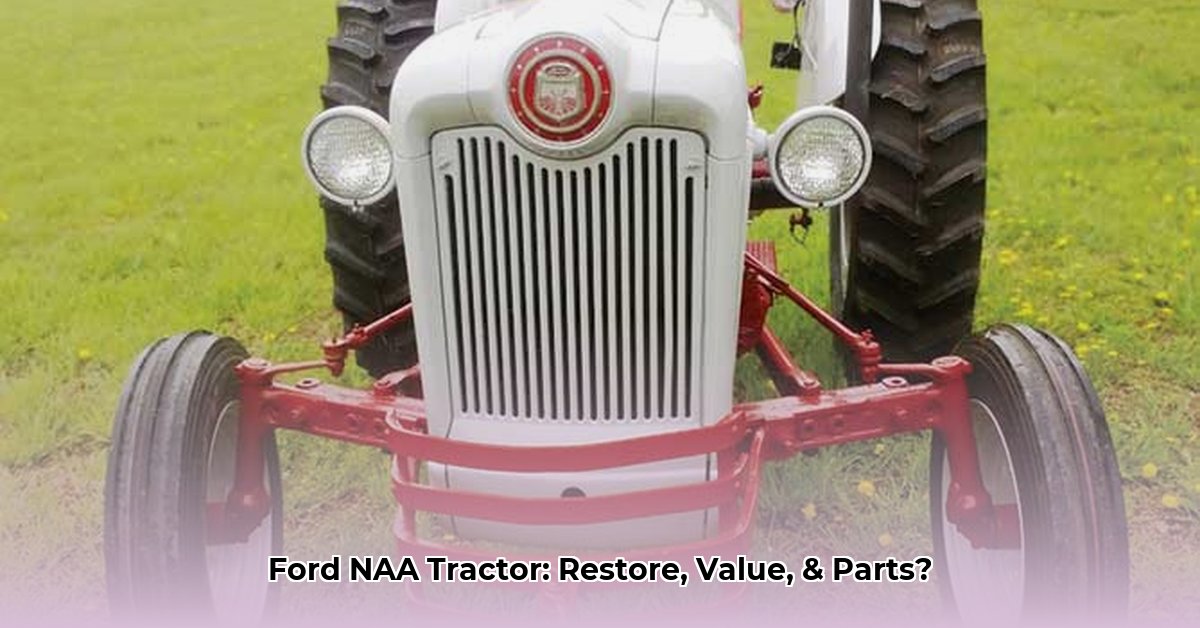
The Ford NAA tractor, a stalwart of the 1950s farm landscape, isn't just a machine; it's a piece of agricultural history. This guide explores the restoration, valuation, and parts sourcing for this iconic tractor, catering to enthusiasts, collectors, and potential investors. Whether you're a seasoned restorer or a curious newcomer, we'll equip you with the knowledge to navigate the world of Ford NAA ownership. For sourcing hard-to-find parts, check out this helpful resource: Ford NAA parts.
Performance and Specifications: Understanding the NAA's Capabilities
The Ford NAA's heart is a 2.2-liter, four-cylinder gasoline engine, generating approximately 30 PTO horsepower (power take-off horsepower, used for implements). While modest by today's standards, this power was sufficient for many smaller farms of its era. Its live rear axle (an axle that turns with the wheels) and relatively simple mechanics contributed to its legendary reliability. However, remember that variations in horsepower figures exist due to differences in measurement methods and the general wear and tear on a vintage tractor.
Figuring Out the Value of Your Ford NAA: Factors Influencing Price
Determining the precise value of a Ford NAA tractor is complex. Auction prices range significantly – from a few thousand dollars to almost $6,000 -- depending on several key factors:
Condition: A meticulously restored, original NAA commands a premium over one needing extensive repairs. A pristine tractor fetches top dollar.
Completeness: Tractors with all original, untouched parts are highly sought after by collectors. Missing parts significantly devalue the tractor.
Rarity: Special editions, such as the 1953 Golden Jubilee model, are highly prized by collectors, greatly increasing their market value.
Location: Geographic location affects demand; a highly desirable model in one region might be less valuable in another.
To gauge value, research current auction listings and compare similar tractors. Online forums and tractor enthusiast groups offer invaluable insights and perspectives from experienced collectors.
Restoring Your Ford NAA: A Step-by-Step Guide
Restoring a Ford NAA is a rewarding but challenging endeavor. Follow these steps for a successful restoration:
Comprehensive Inspection: Begin with a thorough inspection, meticulously documenting the tractor's condition – both good and bad – with photographs. This detailed record serves as a roadmap for your restoration.
Parts Acquisition: Sourcing parts for a vintage tractor requires persistence. Online marketplaces, specialized salvage yards, and classic tractor parts suppliers are crucial resources. Be prepared for creative solutions and potentially long searches.
Mechanical Restoration: Prioritize the mechanical aspects – engine, transmission, and other functional components. Ensure the tractor runs reliably before focusing on cosmetic restoration.
Testing and Refinement: After reassembly, conduct thorough testing to confirm proper functionality before declaring the restoration complete.
Remember that restoration costs can quickly escalate. Budget realistically, incorporating a contingency for unforeseen expenses, a frequent occurrence in such projects. How much would you typically budget for a restoration project of this sort?
Keeping Your Ford NAA Running: Parts and Preventative Maintenance
Maintaining a Ford NAA requires proactive upkeep. Parts availability can be a challenge due to age and discontinued manufacturing. Join online communities and network with parts suppliers to access necessary components. Maintain a detailed inventory of your tractor's parts, noting their condition, and proactively replace worn-out items to prevent future breakdowns.
Ford NAA Ownership: Weighing the Risks and Rewards
This table summarizes potential risks and mitigation strategies:
| Risk Factor | Likelihood | Impact | Mitigation Strategy |
|---|---|---|---|
| Mechanical Breakdown | Moderate | High | Preventative maintenance; build a parts inventory |
| Restoration Costs | High | High | Thorough pre-purchase inspection; detailed budgeting |
| Market Value Fluctuation | Moderate | Moderate | Research market trends; understand restoration costs |
| Parts Availability | High | Moderate | Proactive sourcing; join online communities |
Owning a Ford NAA offers immense satisfaction but requires commitment. For collectors, the restoration process itself is a major reward. For investors, a thorough understanding of market fluctuations, restoration costs, and parts availability is critical. Ultimately, the Ford NAA represents a significant piece of agricultural history, and owning one connects you to that heritage.
How to Accurately Assess the Market Value of a Ford NAA Tractor
Several factors determine a Ford NAA's value, including condition, originality, and location. Professional valuation tools like FleetEvaluator offer a more structured approach than simple online browsing alone. Remember to factor in restoration costs, market trends, and regional demand when determining fair market value. This is a detailed process; it requires dedication and thorough research.
Key Takeaways:
- Value is determined by condition, model specifics, and location.
- Restoration quality significantly impacts price.
- Online resources and professional valuation tools offer market insights.
- Market trends and collector interest constantly shift valuations.
- Parts availability and restoration costs are major value influencers.